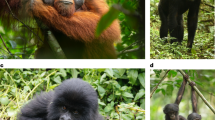Abstract
I review information on the status in the wild of the robust chimpanzee, Pan troglodytes, and consider whether this evidence is consistent with the designation of P. troglodytes as Endangered in the International Union for the Conservation of Nature and Natural Resources (IUCN) Red List, and with public statements to the effect that great apes as a whole will be extinct within a few decades. Chimpanzees remain widespread in tropical Africa, occurring in a variety of forested habitats. Estimates of total surviving numbers have increased from about 200,000 in the 1980s to a maximum of almost 300,000 in 2003. However, this apparent increase comes about from new survey data, rather than representing a measured increase in actual population numbers. Infectious disease decimated several chimpanzee populations during the 1990s, and data from parts of Gabon, extrapolated to that country as a whole, suggest a major decline in great ape populations caused by disease and hunting. However, accurate data on population numbers are absent for the majority of wild chimpanzee populations. I found reports of the presence of Pan troglodytes in at least 51 national parks in at least 19 countries; some of these parks have been established very recently. Chimpanzees also occur in many non-park conservation areas. A set of large, well-protected parks could safeguard chimpanzees for the foreseeable future. Although many African parks do not function well at present, mechanisms to improve their function are understood and available. By a strict application of IUCN threat criteria, P. troglodytes can be considered Endangered, based on estimated rates of past decline and on the species’ long generation time. Relatively speaking, however, P. troglodytes is less endangered than are orangutans or gorillas, and the species is unlikely to go extinct by the year 2100, especially if existing conservation measures improve. The IUCN threat-rating system has become overly complex; the system can produce results that do not accord with common sense and these results must therefore be interpreted with care.

Similar content being viewed by others
References
Bearder SK (1999) Physical and social diversity among nocturnal primates: a new view based on long term research. Primates 40:267–282
Behler DA (2002) Gabon raises the bar. Wildl Conserv 105(6):6–7
Boesch C, Boesch-Achermann H (2000) The chimpanzees of the Taï Forest: behavioural ecology and evolution. Oxford University Press, Oxford
Bruner AG, Gullison RE, Rice RE, da Fonseca GAB (2001) Effectiveness of parks in protecting tropical biodiversity. Science 291:125–128
Butynski TM (2001) Africa’s great apes. In: Beck B, Stoinski TS, Hutchins M, Maple TL, Norton B, Rowan A, Stevens EF, Arluke A (eds) Great apes and humans. Smithsonian Institution Press, Washington, DC, pp 3–56
Butynski TM (2003) The robust chimpanzee Pan troglodytes: taxonomy, distribution, abundance, and conservation status. In: Kormos R, Boesch C, Bakarr MI, Butynski TM (eds) West African chimpanzees Status survey and conservation action plan. IUCN/SSC Primate Specialist Group, Gland, Switzerland, pp 5–12
Butynski TM, Members of the Primate Specialist Group (2000) Pan troglodytes. In: 2003 IUCN Red List of threatened species. Available at www.redlist.org
Carroll RW (1986) Status of the lowland gorilla and other wildlife in the Dzanga-Sangha region of southwestern Central African Republic. Primates Conserv 7:38–41
Caughley G (1994) Directions in conservation biology. J Anim Ecol 63:215–244
Cohen J (1991) Born to be wild. Wash City Paper 11(46):22–29
Collomb J-G, Mikissa J-B, Minnemeyer S, Mundunga S, Nzao HN, Madouma J, Mapaga J de D, Mikolo C, Rabenkogo N, Akagah S, Bayani-Ngoye E, Mofouma A (2000) A first look at logging in Gabon. World Resources Institute, Washington, DC
Edroma EL, Rosen N, Miller PS (eds) (1997) Conserving the chimpanzees of Uganda: population and habitat viability assessment for Pan troglodytes schweinfurthii. IUCN/SSC Conservation Breeding Specialist Group, Apple Valley, MN
Garcia JE, Mba J (1997) Distribution, status and conservation of primates in Monte Alen National Park, Equatorial Guinea. Oryx 31:67–76
Gonder MK, Oates JF, Disotell TR, Forstner MRJ, Morales JC, Melnick DJ (1997) A new West African chimpanzee subspecies? Nature 388:337
Groves CP (2001) Primate taxonomy. Smithsonian Institution Press, Washington, DC
Grubb P, Butynski TM, Oates JF, Bearder SK, Disotell TR, Groves CP, Struhsaker TT (2003) Assessment of African primate diversity. Int J Primatol 24:1301–1357
Harcourt AH (1996) Is the gorilla a threatened species? How should we judge? Biol Conserv 75:165–176
Huijbregts B, De Wachter P, Obiang LSN, Akou ME (2003) Ebola and the decline of gorilla Gorilla gorilla and chimpanzee Pan troglodytes populations in Minkebe Forest, north-eastern Gabon. Oryx 37:437–443
IUCN (2001) The IUCN Red List of threatened species: 2001 categories and criteria (v. 3.1). The International Union for the Conservation of Nature and Natural Resources, Gland, Switzerland
IUCN (2003) 2003 IUCN Red List of threatened species. The International Union for the Conservation of Nature and Natural Resources, Gland, Switzerland. Available at www.redlist.org
Jensen-Seaman MI, Deinard AS, Kidd KK (2001) Modern African ape populations as genetic and demographic models of the last common ancestor of humans, chimpanzees, and gorillas. J Hered 92:475–480
Kingdon J (1997) The Kingdon field guide to African mammals. Academic, San Diego, CA
Kitano T, Schwarz C, Nickel B, Pääbo S (2003) Gene diversity patterns at 10 X-chromosomal loci in humans and chimpanzees. Mol Biol Evol 20:1281–1289
Kormos R, Boesch C, Bakarr MI, Butynski TM (2003a) West African chimpanzees Status survey and conservation action plan. IUCN/SSC Primate Specialist Group, Gland, Switzerland
Kormos R, Humle T, Brugière D, Fleury-Brugière M.-C, Matsuzawa T, Sugiyama Y, Carter J, Diallo MS, Sagno C, Tounkara O (2003b) The Republic of Guinea. In: Kormos R, Boesch C, Bakarr MI, Butynski TM (eds) West African chimpanzees Status survey and conservation action plan. IUCN/SSC Primate Specialist Group, Gland, Switzerland, pp 63–76
Kortlandt A (1983) Marginal habitats of chimpanzees. J Hum Evol 12:231–278
Lee PC, Thornback J, Bennett EL (1988) Threatened primates of Africa The IUCN Red Data Book. IUCN, Gland, Switzerland
Leendertz FH, Ellerbrok H, Boesch C, Coacy-Hymann E, Mätz-Rensing K, Hakenbeck R, Bergmann C, Abaza P, Junglen S, Moebius Y, Vigilant L, Formenty P, Paull G (2004) Anthrax kills wild chimpanzees in a tropical rainforest. Nature 430:451–452
Mace GM, Lande R (1991) Assessing extinction threats: toward a reevaluation of IUCN threatened species categories. Conserv Biol 5:148–157
Marchesi P, Marchesi N, Fruth B, Boesch C (1995) Census and distribution of chimpanzees in Côte d’Ivoire. Primates 36:591–607
Matthews A, Matthews A (2004) Survey of gorillas (Gorilla gorilla gorilla) and chimpanzees (Pan troglodytes troglodytes) in southwestern Cameroon. Primates 45:15–24
Napier JR, Napier PH (1967) A handbook of living primates. Academic, London
Nishida T (1994) Distribution and status of chimpanzee populations in Africa. Pan Africa News 1(2):1–10
Nishida T (2001) The current condition of great apes in the natural environment. Pan Africa News 8(1):6–12
Nishida T, Wrangham, RW, Jones JH, Marshall A, Wakibara J (2001) Do chimpanzees survive the 21st century? In: Chicago Zoological Society (ed) The apes: challenges for the 21st century. Conference Proceedings, May 10–13 2000. Chicago Zoological Society, Brookfield, IL, pp43–51
Nishida T, Corp N, Hamai M, Hasegawa T, Hiraiwa-Hasegawa M, Hosaka K, Hunt KD, Itoh N, Kawanaka K, Matsumoto-Oda A, Mitani JC, Nakamura M, Norikoshi K, Sakamaki T, Turner L, Uuehara S, Zamma K (2003) Demography, female life history, and reproductive profiles among the chimpanzees of Mahale. Am J Primatol 59:99–121
Oates JF (1986) Action plan for African primate conservation: 1986–90. IUCN/SSC Primate Specialist Group, Stony Brook, NY
Oates JF (2003) Protecting the last populations of great apes in Africa. Environ Rev 10(9):9–16
Oates JF, McFarland KL, Groves JL, Bergl RA, Linder JM, Disotell TR (2003) The Cross River gorilla: natural history and status of a neglected and critically endangered subspecies. In: Taylor AB, Goldsmith ML (eds) Gorilla biology: a multidisciplinary perspective. Cambridge University Press, Cambridge, pp 472–497
Plumptre AJ, Cox D, Mugume S (2003) The status of chimpanzees in Uganda Albertine Rift Technical Report Series no 2. Wildlife Conservation Society, Bronx, NY
Poulsen JR, Clark CJ (2004) Densities, distributions, and seasonal movements of gorillas and chimpanzees in swamp forest in northern Congo. Int J Primatol 25:285–306
Sunderland-Groves JL, Maisels F (2003) Large mammals of Takamanda Forest Reserve, Cameroon. In: Comiskey JA, Sunderland TCH, Sunderland-Groves JL (eds) Takamanda: the biodiversity of an African rainforest. Smithsonian Institution Press, Washington, DC, pp 111–127
Teleki G (1989) Population status of wild chimpanzees (Pan troglodytes) and threats to survival. In: Heltne PG, Marquardt LA (eds) Understanding chimpanzees. Harvard University Press, Cambridge, Mass., pp 312–353
Teleki G, Baldwin L (1979) Known and estimated distributions of extant chimpanzee populations (Pan troglodytes and P. paniscus) in Equatorial Africa. Unpublished report to the IUCN/SSC Primate Specialist Group
Terborgh J, van Schaik C (2002) Why the world needs parks. In: Terborgh J, van Schaik C, Davenport L, Rao M (eds) Making parks work: strategies for preserving tropical nature. Island Press, Washington, DC, pp 3–14
Tutin CEG (2001) Saving the gorillas (Gorilla g gorilla) and chimpanzees (Pan t troglodytes) of the Congo Basin. Reprod Fertil Dev 13:469–476
Tutin CEG, Fernandez M (1984) Nationwide census of gorilla (Gorilla g gorilla) and chimpanzee (Pan t troglodytes) populations in Gabon. Am J Primatol 6:313–336
Usongo L (2001) Present situation of great apes (Gorilla gorilla gorilla and Pan troglodytes) in Cameroon. In: Chicago Zoological Society (ed) The apes: challenges for the 21st century. Conference Proceedings, May 10–13 2000. Chicago Zoological Society, Brookfield, IL, pp331–333
van Schaik C, Terborgh J, Davenport L, Rao M (2002) Making parks work: past, present, and future. In: Terborgh J, van Schaik C, Davenport L, Rao M (eds) Making parks work: strategies for preserving tropical nature. Island Press, Washington, DC, pp 468–481
Walsh PD, Abernethy KA, Bermejo M, Beyers R, De Wachter P, Akou ME, Huijbregts B, Mambounga DI, Toham AK, Kilbourn AM, Lahm SA, Latour S, Maisels F, Mbina C, Mihindou Y, Obiang SN, Effa EN, Starkey MP, Telfer P, Thibault M, Tutin CEG, White LJT, Wilkie DS (2003) Catastrophic ape decline in western equatorial Africa. Nature 422:611–614
Wich SA, Singleton I, Utami-Atmoko SS, Geurts ML, Rijksen HD, van Schaik CP (2003) The status of the Sumatran orangutan Pongo abelii: an update. Oryx 37:49–54
Wrangham RW, Hagel G, Leighton M, Marshall AJ, Waldau P, Nishida T (2005) The great ape world heritage species project. In: Mehlman P, Steklis D, Stoinski T (eds) Conservation in the 21st Century: gorillas as a case study. Kluwer Academic, New York (in press)
Yamagiwa J, Mwanza N, Spangenberg A, Maruhashi T, Yumoto T, Fischer A, Steinhauer-Burkart B, Refisch J (1992) Population density and ranging patterns of chimpanzees in Kahuzi-Biega National Park, Zaire: a comparison with a sympatric population of gorillas. Afr Study Monogr 13:217–230
Acknowledgments
I am most grateful to Professor Juichi Yamagiwa and the organizing committee for inviting me to participate in the Kyoto symposium held in honor of the retirement of Professor Toshisada Nishida. I was especially happy to be able to attend this meeting because of my respect for Professor Nishida’s contributions to primatology and conservation. For providing information about chimpanzee study groups I am grateful to Christophe Boesch, Elizabeth Greengrass, Tetsuro Matsuzawa, Toshisada Nishida, Vernon Reynolds, David Watts and Richard Wrangham. For providing information on African national parks and their chimpanzee populations I am grateful to Paul Aczel, Allard Blom, Geneviève Campbell, Patrice Christy, Roger Fotso, Fiona Maisels, Andrew Plumptre, Melissa Remis, Emma Stokes, Janette Wallis and Lee White. I thank Tom Butynski and Rebecca Kormos for giving permission to reproduce the map in Fig. 1 and Kim Meek of Conservation International for modifying this map for publication. Revision of a first draft of this paper benefited from comments from Tom Butynski and Toshisada Nishida.
Author information
Authors and Affiliations
Corresponding author
About this article
Cite this article
Oates, J.F. Is the chimpanzee, Pan troglodytes, an endangered species? It depends on what “endangered” means. Primates 47, 102–112 (2006). https://doi.org/10.1007/s10329-005-0149-5
Received:
Accepted:
Published:
Issue Date:
DOI: https://doi.org/10.1007/s10329-005-0149-5




